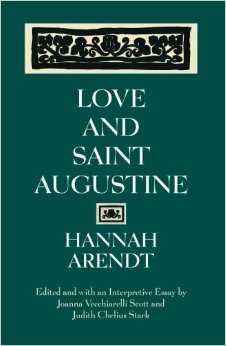Der Liebesbegriff bei Augustin. Berlin: Julius Springer Verlag, 1929. Translation as Love and Saint Augustine, with an interpretive essay by Joanna V. Scott and Judith C. Stark. Chicago: University of Chicago Press, 1996.
Summary:
Hannah Arendt began her scholarly career with an exploration of Saint Augustine’s concept of caritas, or neighborly love, written under the direction of Karl Jaspers and the influence of Martin Heidegger. After her German academic life came to a halt in 1933, Arendt carried her dissertation into exile in France, and years later took the same battered and stained copy to New York. During the late 1950s and early 1960s, as she was completing or reworking her most influential studies of political life, Arendt was simultaneously annotating and revising her dissertation on Augustine, amplifying its argument with terms and concepts she was using in her political works of the same period. The dissertation became a bridge over which Arendt traveled back and forth between 1929 Heidelberg and 1960s New York, carrying with her Augustine’s question about the possibility of social life in an age of rapid political and moral change.
Table of Contents:
Preface: Rediscovering Love and Saint Augustine
Acknowledgments
LOVE AND SAINT AUGUSTINE
Introduction
Part I: Love as Craving: The Anticipated Future
1. The Structure of Craving (Appetitus)
2. Caritas and Cupiditas
3. The Order of Love
Part II: Creator and Creature: The Remembered Past
1. The Origin
2. 2. Caritas and Cupiditas
3. Love of Neighbor
Part III: Social Life
1. Introduction: “New Beginnings”
2. “Thought Trains”
3. Heidegger: Arendt between the Past and Future
4. Jaspers: Arendt and Existenz Philosophy
References
Index

